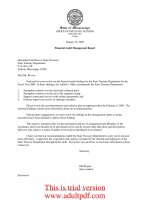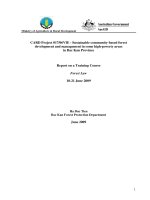ORDER MANAGEMENT REPORT
Bạn đang xem bản rút gọn của tài liệu. Xem và tải ngay bản đầy đủ của tài liệu tại đây (585.97 KB, 17 trang )
1
INS3073
ORDER MANAGEMENT
GROUP ASSIGNMENT
Class
: MIS2016A – VNU-IS
Group Name
:5
Group Members
: Trinh Thi Lan Anh
Tran Nga My
Nguyen Minh Hang
Le Cao Vu
1
2
INS3073
GROUP MEMBER
Name
Nguyen Minh Hang
Trinh ThiLanAnh
Tran Nga My
Le Cao Vu
Student ID
16071280
16071269
16071294
16071321
2
3
INS3073
Table of Contents
3
4
INS3073
List of Figure
4
5
INS3073
The report on topic Order Management explores several different order
management transactions with characteristics and complications encountered when
modelling these transactions. Each dimension with its characteristic is used to analyse
and discuss.
II. Analysis
1. Problem introduction
Nowadays, trading industry is more and more developing and plays an important
role in Gross Domestic Product of our country. One of the essential parts of trading is
Ordering which is the first activity to create an adequate, timely, synchronous, correct
input (for enterprise) being suitable for customer demand and plans of the business.
Therefore, in this project, we set up a system to provide a process for managing
information from purchase to payment including functions such as quoting, ordering,
shipping, invoicing, payment and customer return.
We can imagine an enterprise data warehouse as the following figure (figure 1):
Figure 1: Bus matrix rows for order management processes
5
6
INS3073
This is bus matrix for order management which has included Quoting, Ordering,
Shipping to Customer, Shipment Invoicing, Receiving Payments, Customer Returns,
… All these facts are valuated by criteria as Date, Customer, Product, Deal,
Warehouse, Shipper.
2. Algorithm question:
In order to answer the question: how to optimize the importing goods and manage
inventory in order management, we base on the following mining questions:
•
What kind of products that customer prefer the most/least?
•
Which month of the year sells the most?
•
What is the quantity of goods in inventory compared to quantity of stock in
trade?
II. Database design
The database design is to describe the customer ordering process to determine
the quantity of goods to enter in the inventory of each month.
It is to look more closely at the customer order data. Each customer when
ordering will generate an invoice, the invoice includes customer information and
product information. A customer may have multiple invoices with different products
and different order dates. Then, based on the quantity ordered by the customer,
transfer the information to the warehouse and the warehouse delivers it to the
customer. After the ordering process has been completed, the warehouse will calculate
the amount of inventory and replenishment.
6
7
INS3073
Figure 2: Database
Description attributes:
In the database system, we have some attributes as following:
-
Order management system: means the system has the function of creating
-
information about customer orders for the company.
Customer: who use the service of the company.
Product: products that customers want to order.
Bill: include the information of customer and product, the date the item was
-
shipped.
Warehouse: the information of warehouse such as location, product quantity, stock
in trade quantity.
7
8
INS3073
Figure 3: Design Entity Relationship Diagram
III. BUILDING THE DATA WAREHOUSE
After studying the case study at the first part and Entity Relationship Diagram at
the second part, the group has made the dimension model being designed following
the four main steps.
Step 1: Select the Business Process
The first step in the design is to decide what business to model by combining an
understanding of business requirements with an understanding of the available source
data.
In order management case study, the manager wants to see the quantity of goods
that customers order monthly, which is the best seller and which sells the least. Thus
the business process be going to model is customer order. This data enables the
business user to analyze and understand customer’s features, usage habit and business
status of organization.
8
9
INS3073
The schema is applied in this use case is Star schema which include one fact
table and many dimension table around. They are many to one relationship.
Step 2: Declare the Grain
Managed by month.
Step 3: Identify the Facts
The facts chosen in the model are Customer ID, Warehouse ID, Product ID, Bill
ID, Order Quantity, Stock in Trade, Quantity in Warehouse.
The description fact:
-
Customer ID: The ID number of each customer.
Warehouse ID: ID of warehouse.
Product ID: ID of the product.
Bill ID: each bill has different ID.
Order quantity: quantity of product that customer order.
Stock in Trade: quantity of product in stock after shipping to customers.
Quantity in Warehouse: total number of product in warehouse.
Step 4: Identify the Dimensions
In this step, we divide into 4 following dimension tables: Customer Dimension,
Product Dimension, Bill Dimension and Warehouse Dimension.
Dimension Table Details
1. Customer
This table presents information of every customer. The information will be
updated when any new customer uses the service and has bill.
Description attributes
Customer dimension stores four attributes such as: Customer ID, Customer
Name, Customer Address, Customer Phone number.
In this dimension, Customer ID attribute will be unique primary key. The primary key is
used to uniquely identify each record in the database table. In addition, it is used to
establish a 1-n relationship between two dimensions. The data of the primary key field is
unique and does not contain Null values.
9
10
INS3073
Figure 4: Customer Dimension
2. Bill
Basing on bill dimension, you can find out fully information of invoicing. Each
bill has only one bill ID which is primary key for distinguishing. Foreign keys such as
customer ID and product ID associated with customer dimension and product
dimension to show their needed information in invoice. Customers can see which
products they bought and shipper can see which customers they need to ship products.
Export date describes the date customers receive bill as well as their products.
Figure 5: Bill Dimension
3. Product:
10
11
INS3073
Product dimension describes fully information of products from ordering to
billing. Each product has only one primary key is product ID. This product ID is not
limit the number of quantity. Product dimension has one foreign key is customer ID
associated with customer dimension. Other attributes such as price, product name,
product brand and quantity are fully information of products.
Figure 6: Product Dimension
4. Warehouse:
Each warehouse has only one warehouse ID which is primary key. Warehouse
key helps you determine warehouse location, quantity in warehouse as well as the
quantity of stock-in-trade.
Figure 7: Warehouse Dimension
The complete data warehouse
11
12
INS3073
After covering through all four steps of designing dimension model, we have
drawn a complete design as following and we use CusID (from customer dimension),
ProductID (from product dimension), WarehouseID (from warehouse dimension),
BillID ( from bill dimension) are foreign key in order management fact table.
Figure 8: Complete data warehouse design
IV. Answer query questions
12
13
INS3073
•
What kind of products that customer prefer the most/least?
Figure 9: What kind of products that customer prefer the most/least?
In this figure, the company has 5 products, by visualization, we find out the
Contrast chunky sole trainers is the most purchase of customer and the Beige heels is
the least.
•
Which month of the year sells the most?
13
14
INS3073
Figure 10: Which month of the year sells the most?
The table shows that May is the month with the most orders in the year.
14
15
INS3073
•
What is the quantity of goods in inventory compared to quantity of stock in
trade?
Figure 11: What is the quantity of goods in inventory compared to quantity of stock in trade?
The figure shown the different of total products and quantity of the stock in trade product.
Contrast chunky sole trainers is the most sold product but lacks stock in the warehouse.
Some other items still have quite a lot.
V. RESULT AND DISCUSSION
1. Result
The case study is about the situation of a order management company that needs
employee for designing data warehouse for business process. In addition, this design
must help manager able to see the monthly order by customer. Based on manager’s
requirement, the team also has built a draft design already. After analyzing case study, we
has realized a big questions:
How to optimize the importing goods and manage inventory in order management?
15
16
INS3073
Right after realizing the requirement of case study, we spend all our effort and
time to discuss, propose and solve the question above. As a result, we has had
achievements as following:
Develop sophisticated forecast models:
Effective forecast models are key to knowing when to increase or reduce
stock levels based on changing buying activity. Software tools, especially
those that process data from a variety of sources, can usually help with
accurate forecasting. It’s also worth gathering information from different
parts of the supply chain, like manufacturers and suppliers, to supplement
your own data.
Optimize Your Inventory
Reports and past records can help business analyze past inventory levels.
Thus, companies can optimize how much inventory they keep on hand. By
doing this, the company can also reduce the costs of storing excess inventory.
Optimizing their inventory levels can decrease the amount of overstocks and
stock shortages. This will lower shipping costs, and the amount of obsolete
stock that the company retains.
Track Inventory Accurately
It is vital to make sure that company have the correct inventory levels at all of
warehouse locations. An inventory management system has tools to help the
company do this. As a result, the company can ensure that stock is ordered on
time and use reports to reduce overstocks and stock shortages. Also, the
company can create purchase orders, and make sure items are picked, packed
and shipped. Automating their inventory processes will reduce errors when
tracking the warehouse. Use Electronic Data Interchange and barcode
scanning to track every stage of the process.
16
17
INS3073
2. Discussion
In this project, we research order management as well as its process. To achieve
this goal, we need to design the database and build the appropriate data warehouse.
However, we also identify some problems need to bring to discuss and improve. And
we also believe that if we have more time, we can do better some elements as
following:
Firstly, we can have more records in data warehouse to be able analyze and see
more detail of business background.
Secondly, if our team has more knowledge, skills and experience, we can solve
this case study more perfectly and offer more solutions with order optimization and
warehouse management.
VI. REFERENCES
(1)
Ralph, K. and Margy, R. (2017). The Data Warehouse Toolkit, 3rd Edition.
Harlow, United Kingdom: Pearson Education Limited.
17









